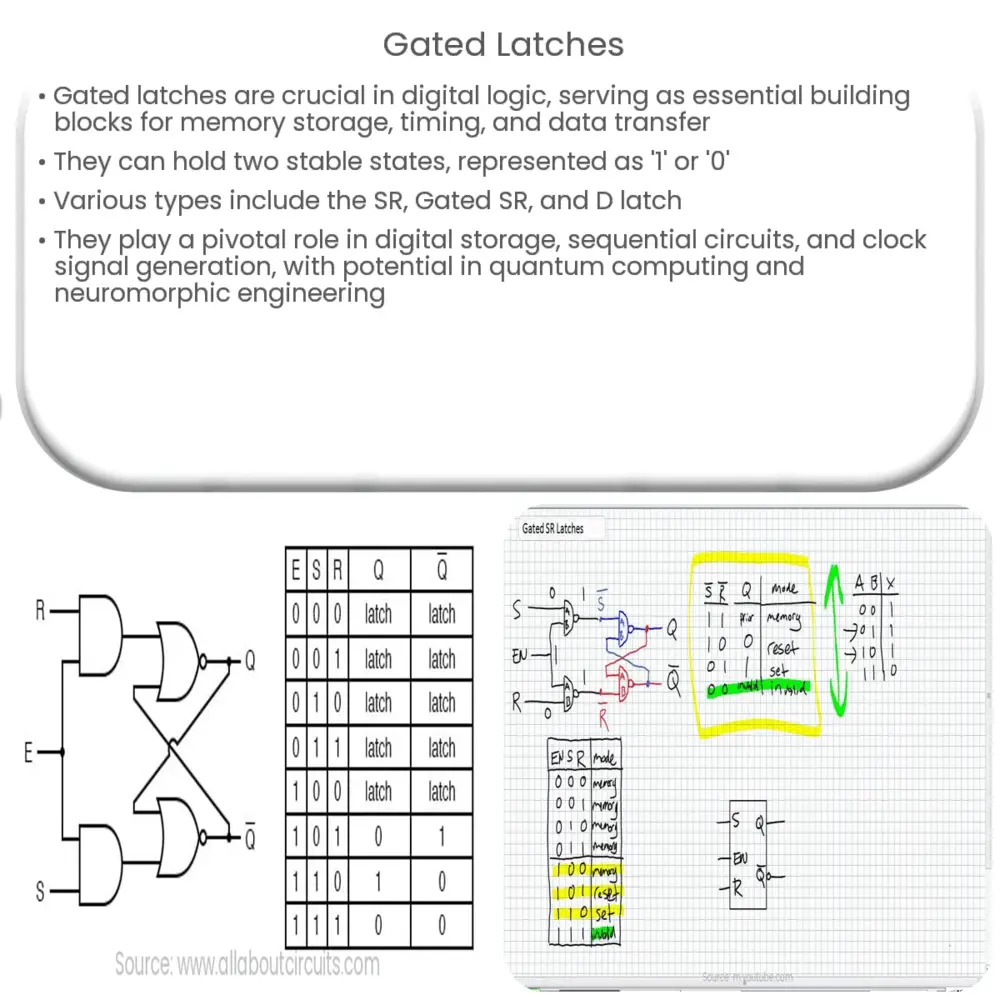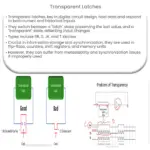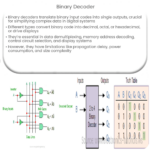Explore the basics of gated latches, their types, operation, applications in digital systems, and their role in future technologies.

Gated Latches: The Cornerstone of Digital Logic
In the world of digital logic, gated latches hold a position of significant importance. These devices, fundamental building blocks in digital systems, are essential in memory storage, timing operations, and data transfer.
What Are Gated Latches?
A gated latch is a simple storage device that can retain and modify a binary state. It’s made up of logic gates and has two outputs. One of the critical features of a latch is that it is a bistable device – this means it can hold two stable states, typically represented as ‘1’ or ‘0’ in digital terms.
Types of Gated Latches
- SR Latch: The SR (Set-Reset) latch is the simplest type of latch, consisting of two cross-coupled NOR or NAND gates. It has two inputs, S for set and R for reset, and two outputs, Q and its complement Qbar.
- Gated SR Latch: A variation of the SR latch, the Gated SR latch incorporates an additional ‘enable’ input. This input determines whether or not the latch should respond to changes in the other inputs.
- D Latch: The D (Data) latch is another type of latch that solves the undefined state problem in the SR latch. It has one input (D) and two outputs (Q and Qbar). When the enable input is high, the Q output follows the D input.
The Principle of Operation
The basic operation of a latch involves setting and resetting its state. When the set input (S) is triggered, the latch switches to the ‘set’ state, storing a ‘1’. When the reset input (R) is triggered, it switches to the ‘reset’ state, storing a ‘0’. In the case of the D latch, the state of the Q output follows the state of the D input as long as the enable input is active.
Application of Gated Latches
Gated latches are used in a wide variety of applications within digital systems. One of their primary uses is in digital storage. They form the basis for flip-flops, which in turn form the basis for much of modern computer memory, such as RAM and cache memory. They also play a vital role in timing and synchronization within digital circuits, ensuring that data is processed in the correct sequence.
Gated Latches in Sequential Circuits
Sequential circuits are a fundamental component of digital systems, utilizing gated latches for maintaining their states. In contrast to combinational circuits, which depend solely on current inputs, sequential circuits take their previous state into account, allowing them to ‘remember’ information.
Examples of sequential circuits include counters, registers, and memory units, all of which employ latches and flip-flops to store and manipulate data. The operation of these circuits underlines the significance of gated latches in forming the backbone of complex digital systems.
Gated Latches in Clock Signal Generation
Another crucial use of gated latches is in generating clock signals. These periodic signals serve as a synchronization source in digital systems, dictating the sequence of operations within a circuit. Without these, the multiple components of a complex digital system might operate asynchronously, leading to incorrect outcomes.
- Frequency Division: Gated latches can be arranged in a series to generate lower frequency signals from a higher frequency clock signal, a process known as frequency division.
- Phase-locked loops (PLLs): PLLs, used for clock signal synchronization and recovery, contain a voltage-controlled oscillator (VCO) controlled by a feedback loop. Gated latches within the feedback loop allow the PLL to lock onto the phase of an input signal.
Future Directions
With advancements in technology, the role of gated latches is continually expanding. They are integral to the development of quantum computing, where quantum bits or ‘qubits’ can exist in superposition states, going beyond the binary logic of conventional computing. Moreover, in the realm of neuromorphic engineering, gated latches are being adapted to mimic the synaptic behavior of neurons, heralding a new era in artificial intelligence.
Conclusion
In conclusion, gated latches are much more than mere binary storage devices. They are the pillars upon which digital systems stand, facilitating data storage, timing operations, and synchronization. From forming the heart of digital memory to aiding in clock signal generation, and even holding promise for future technologies like quantum computing and neuromorphic engineering, the importance of understanding and harnessing the potential of these devices is greater than ever.




